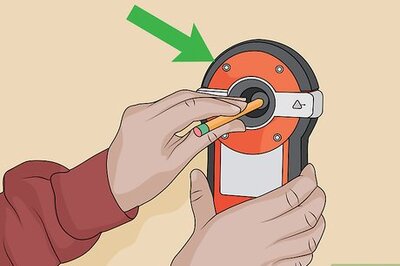
views
Cleaning Mold Off Wood
Put on protective gear and prepare the area. Mold and mold spores can be dangerous if inhaled, so put on protective gear like gloves, goggles, an N-95 mask, and, if possible, a full-body protective suit. Depending on where the moldy area is, seal it off so the spores don’t spread. Cover clean areas with plastic sheeting to protect them. In general, the same process is used to clean mold off both finished and unfinished wood. If you don’t have a full-body protective suit, wear long sleeves and pants to cover as much exposed skin as possible. Mold is likely to grow on wooden surfaces and areas like decks, fences, and house siding that are often exposed to moisture or standing water or that are in shady areas that don’t dry well.
Prepare and apply a cleaning solution. It’s possible to remove mold using commercial mold cleaners or DIY cleaning solutions. Test whichever solution you choose in an inconspicuous area to make sure it doesn’t damage the wood, then apply it to the mold—typically with a spray bottle or a clean cloth. Here are some common mold-killing options: Vinegar: Vinegar is a natural, non-toxic solution that can kill most types of surface mold. Mix equal parts water and white vinegar and spray the solution on the moldy surface. Baking soda: Baking soda works well for mold in sensitive areas. Mix 1/4 tbsp (5 g) of baking soda in a spray bottle filled with water. Shake until it dissolves, then spray it on the affected area. Hydrogen peroxide: Hydrogen peroxide is a stronger option for stubborn mold stains. Spray 3% hydrogen peroxide on the mold or apply it with a cloth. Commercial mold removers: Some mold removers, like Woodrich’s Wood Cleaner & Mildew Stain Remover, are designed specifically for removing mold from unfinished wood. Check the label to make sure your commercial remover is safe to use on wood, then follow the instructions to apply it.
Scrub the surface. Use a soft-bristle brush to scrub the cleaner into the mold. Reapply the cleaning solution as necessary until all visible mold is gone. Be careful not to soak the area, as excess moisture can cause more mold to grow. If your cleaner doesn’t seem to be working, try a stronger option.
Rinse and dry the wood thoroughly. Use a clean, damp microfiber cloth to wipe away your cleaning solution and loosen any remaining mold spores. Then, use a clean, dry microfiber cloth to remove as much dampness as possible. Let the wood air dry by placing it in direct sunlight or use a fan to speed up the drying process. Make sure the damp cloth isn’t overly wet to prevent excess moisture from soaking into the wood.
Sand the wood, if needed. Examine the wood after it’s completely dry. If it’s become discolored or rough because of the mold, use fine-grit sandpaper to gently smooth the surface until its appearance is consistent.
Treat the wood with a mold-resistant finish. To prevent mold from growing in the future, apply a mold-resistant finish or sealant once the wood is completely dry and clean. This is especially important if the wood is in a humid area. Follow the manufacturer’s instructions to apply the finish or sealant correctly. Kapur says it’s important to seal wood, especially things like decks, “so the mold doesn’t entrench itself into the substrate,” meaning it will sit on top of the sealant rather than in the wood itself. Kapur recommends fiber lock paint: “It's a specific paint that basically seals the mold in and then it dies off.”
Clean up and throw away moldy items. Even if you’ve done your best to cover yourself and your work area, mold spores can still spread. Throw away anything with mold on it and thoroughly disinfect your tools before using them again. Wash your hands well and change your clothes after you’ve completed clean-up. If possible, use a HEPA vacuum to capture any mold spores in the air.
Cleaning Mold Off Wood Floors and Ceilings
Locate the mold’s source and clear the area. Before you start trying to remove the mold, find out where it’s coming from, like a leak somewhere in the floor or ceiling. It’s important to address the problem first to make sure the mold doesn’t grow back. Then, clear the area of any furniture. If there’s a lot of mold or you’re afraid there’s hidden mold you can’t see, consider hiring a professional instead to make sure it’s all taken care of. Remember to wear your protective gear while you work.
Spray the mold with a vinegar and dish soap solution. Fill a spray bottle with half white vinegar and half dish soap and water. Spray the affected floor or ceiling and let the solution sit for 10 minutes. Then, wipe away the mold. When all the mold has been removed, use a clean, damp cloth to wipe away the cleaning solution, then allow the area to dry completely. Check the area every few weeks to make sure the mold hasn’t returned. If it has, it may be time to hire a professional. Try hydrogen peroxide or a commercial mold killer if the mold has spread. Let the solution soak for a few minutes, then scrub the mold with a stiff-bristle brush.
Cleaning Mold Off Wood Furniture
Use detergent and water on most wooden furniture. In many cases, a mixture of household detergent and water will be enough to remove mold from wooden furniture and other surfaces. Wearing your protective gear, dip a brush or sponge into the solution and gently scrub off all visible mold. Do not rinse the wood afterward, as this will only add more moisture, which could cause more mold to grow. Dry the wood as quickly as possible. Wipe up as much moisture as possible with a cloth or towel, then turn on fans or set the piece of furniture out in the sun to speed up the drying process. If detergent doesn’t work, try using a stronger mold-killing solution, like hydrogen peroxide. Be sure to test it in an inconspicuous area first. It may be necessary to sand the wood if any stains remain after you’ve removed the mold. Use the finest grit sandpaper available, and keep your protective gear (especially your N-95 mask) on while you work. If there’s a lot of mold, consider having the wood replaced instead.
How to Prevent Mold on Wood
Inspect and repair wooden structures regularly. Examine wooden structures (especially those outdoors) for signs of mold or moisture. Look for issues like leaks, cracks, or loose joints that may allow water to accumulate on or near the wood. Fix any issues as soon as possible, and replace severely damaged or rotten wood to prevent mold growth.
Use mold-resistant sealants. Apply a mold-resistant sealant or paint to unfinished and/or outdoor wood, following the manufacturer’s instructions. This will help create a barrier that repels water and prevents mold spores from growing. Reapply periodically, especially if you notice signs of wear and tear.
Clean wooden surfaces regularly. Wipe off any standing water (like after rain or from watering plants) as soon as possible so it doesn’t seep into the wood. Use a soft brush and a mild detergent to clean wooden surfaces regularly to remove dirt, debris, and early signs of mold.
Improve air circulation. In outdoor areas, trim any vegetation near your wooden surfaces. Overgrown bushes, trees, and plants can retain moisture, creating a favorable environment for mold. If possible, place structures in sunny areas, as mold thrives in dark, damp places. For indoor wooden structures, open windows, turn on fans, and use a dehumidifier to improve the air quality. Kapur recommends setting your dehumidifier to 50% or 55%. He says, “Mold hates any kind of air movement, [and] the dehumidifier does that, as well, because it constantly takes [in] air and then spews it out.”
Signs of Mold
Black, white, or green spots Mold often appears as black, white, green, brown, or yellow spots. These may begin as small spots that grow to larger patches over time if left untreated. These spots are especially common around areas with water damage. Not all discoloration on wood is an indication of mold. Wood has natural color variations that can sometimes resemble mold patches. The color and texture should be uniform if it’s a natural part of the wood. Water stains can also resemble mold growth, but they lack the fuzzy texture and musty odor common with mold. Water stains are often light brown or yellow and are confined to specific areas affected by water damage. If you aren’t sure if a discolored spot is mold, dab a small bit of household bleach on it. If it lightens quickly, it’s likely mold. If it doesn’t, it’s probably a natural part of the wood.
Rough or fuzzy texture Most mold has a fuzzy or velvety texture, especially in areas with high moisture or humidity levels. In some cases, it may also feel rough or slimy. Examine wooden surfaces for any fuzzy growth or changes in texture, as this is a strong indication of mold.
Musty smell This may not be as noticeable if the moldy structure is outdoors, but mold has a distinctive musty, earthy odor. If you notice a persistent musty odor in an area with wooden surfaces, check for other signs of mold.
Risks of Mold
Prolonged exposure to mold can cause health problems. While most people will not experience severe health issues related to mold, prolonged exposure can sometimes lead to health problems for those who suffer from allergies or respiratory conditions, like asthma. This can range from mild allergic reactions to severe respiratory stress, so it’s important to remove mold as soon as possible.
Mold can cause wood to rot. In addition to causing health risks and being unsightly, mold causes severe structural damage to wood, as it causes the wood to gradually decay. In turn, this can compromise the structural integrity of buildings.
When to Call a Professional
Hire a pro if the mold is in an area larger than 10 sq ft. The EPA (Environmental Protection Agency) recommends professional mold remediation if the moldy area is larger than 10 sq ft, if there is excessive water damage, or if the damage was caused by sewage or contaminated water. It’s also a good idea to hire a professional if you’ve already tried to remove the mold yourself and it didn’t work or the mold keeps coming back, or if you or someone in your household has mold-related health issues.
Cleaning Mold Off Wood FAQs
Can mold be fully removed? It isn’t possible to remove all mold spores from a home. There are too many cracks and crevices the spores can get into. Small amounts of mold spores are normal and likely won’t cause harm, but it’s important to remove all visible signs of mold as soon as possible. Using air purifiers and HEPA filters can help reduce mold spores in the air. Kapur says, “You'll always have mold. We eat cheese—cheese is made out of mold. We've been living with mold for millions of years. It's not the end of the world.” So, unless you see visible patches of mold, don’t stress too much about the possibility of mold spores in the air.
Can you clean mold off wood with bleach? It isn’t recommended to use bleach to remove mold from wood. While bleach can be effective on other surfaces, its corrosive properties can actually damage wood. Wood is also porous, so trying to clean it with bleach could actually push the mold deeper into the wood, as bleach can’t reach the core of wood.
Should you test for mold? The CDC (Center for Disease Control) does not recommend mold testing. All mold can cause structural damage and people can get sick from any type of mold. It’s important to remove mold as soon as possible rather than waiting for test results. Kapur says, “You need to send in a sample [of mold] for the lab to [identify it]. You can’t do it visually. You can identify [that mold is present], but you can't identify what type it is. There are a million and a half different species of mold. We narrowed them down to about six [types]. When we send them for a lab analysis, they narrow it down [to one of those] categories.”
What causes mold? Mold is a type of fungus that forms in warm, damp environments. It’s commonly caused by sources of moisture, like leaks or humid areas, that are left untreated. It thrives in damp, dark areas that lack proper ventilation. It’s often found in areas like basements and crawl spaces.
How does mold spread? Mold spreads by releasing spores that travel through the air or water. They often land on fabric, pet fur, and building materials which allow them to spread even further. There will almost always be some mold spores in the air, and they’re usually nothing to worry about.



















Comments
0 comment